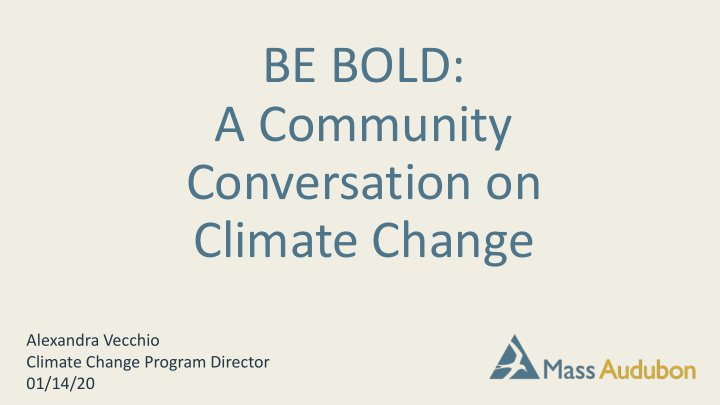



BE BOLD: A Community Conversation on Climate Change Alexandra Vecchio Climate Change Program Director 01/14/20
Agenda 1. Introduction to Climate Communications and Project Drawdown 2. What is the Town of Sudbury doing to address climate change? 3. Solutions Focused Community Conversations 4. Individual Reflection & Commitments 5. Q & A
Climate change: 1. Experts agree. 2. It’s real. 3. It’s bad. 4. It’s us. 5. We can fix it.
A natural change of 100ppm normally occurs over 5,000 to 20,000 years . The recent increase of 100ppm has taken 120 years . Source: NOAA Climate.gov
T emperatures have warmed 2.9°F in Massachusetts since 1895. If we don’t reduce emissions, temperatures could rise 10 °F or more by 2100. Source: CMIP3 downscaled data & Union of Concerned Scientists
Migrating Massachusetts By the end of the century, summers in Massachusetts will “feel” more like summers in the South. Source: CMIP3 downscaled data & Union of Concerned Scientists
Future Climate Changes in MA 3 to 11 ° F Temperature: by 2100 5 weeks Growing Season: by 2100 3 to 7' Sea Level Rise: by 2100 47% David L. Ryan/The Boston Globe via Getty Strong Storms: by 2100 Source: NCICS State Summaries, Fourth National Climate Assessment, and NE CSC
Ok, that sounds alarming…. What should I do?
“Deniers” vs “Believers”
Effective Climate Action • Requires productive public discourse and civic engagement • 72% of Americans understand climate change is happening now • Yet, 65% of Americans discuss climate change only occasionally or never • Practice makes perfect – time to join the discussion Your Voice Is Needed
Climate Communications 101 1. Find common ground and meet people where they are on climate change 2. Emphasize how climate change affects us here and now , in our everyday lives. Stay place-based and local . 3. Focus on how climate change engagement ultimately makes their lives and livelihoods better 4. Creatively empower people to take meaningful and purposeful action on climate change 5. “Smarten Up” climate change communications to match the demands of the audience you are trying to reach
Mitigation: Actions taken to prevent or reduce GHG emissions
Adaptation: Actions taken to help communities and ecosystems cope with actual/expected effects of climate change Conserve available Restore resilience in Integrate concepts open space into new urban areas at site providing ecosystem development at specific scale services neighborhood scales
There are real solutions that already exist One of the best climate change actions is preserving natural areas.
Salt Marshes as a Solution
Urban & Open Space Every year, urban forests in the 15 communities of MetroWest Boston BU Urban Climate Initiative Source: Hong-Hanh et al. 2018 Remove Store Help avoid 7.5 million 962,000 tons 527 million gal. pounds of air of carbon, worth of stormwater pollutants $125 million runoff, worth $4.7 million
Salt Marshes as a Solution Green the Grid: Community Choice Aggregation Municipalities can buy renewable energy in bulk to serve consumers in their city or town
The Concept: Drawdown The term "Drawdown" refers to the point in which the global concentration of greenhouse gases peak and then go down continually on a year-to-year basis
Drawdown Solutions Ranked by the potential to avoid or sequester the amount of GHG's in the atmosphere from 2020-2050. 7 Solution Categories: Land, Energy, Food, Women & Girls, Buildings & Cities, Transport, Materials All but two solutions are "No Regret Solutions" This is due to the economic, social, and health benefits.
#54 Walkable Citie ities Key drivers of Walkability: Demand, density, design, destination, distance, & diversity Health, economic, social, and aesthetic benefits of walkable cities GHG Impact: 5 percent of trips currently made by car can be made by foot instead by 2050. That shift could result in 2.9 gigatons of avoided carbon dioxide emissions and reduce costs associated with car Guangzhou, China ownership by $3.3 trillion.
Rami Alwan Chair of Energy & Sustainability Committee Beth Suedmeyer Environmental Planner- Planning & Community Development Department
Ask Yourself…. • What issues am I excited about? • What do I need to know? • Who do I need to talk to? • How can I create collective action? Be patient….but persistent!
Moving from “Me” → “We” Community City or Town State / Region (neighborhoods, schools, institutions, workplaces, public spaces) Installing rooftop solar at school Community Choice Greening the Grid Electricity Generation or work Aggregation Transportation Food Buildings & Cities Land Use Materials
Think, , Pair, , Share 1. How could this solution be relevant to Sudbury or New England at-large? 2. Do you think this solution is socially, economically, and ecologically practical? 3. Does this solution excite you? Why or why not? 4. Who should be "at the table" if such a solution were to be implemented? 5. Can you think of an example where this solution already exists?
2050: The Future I Imagine
Continuing the Conversation 1. What did you learn that was new? 2. Where should Sudbury go from here? 3. How will you continue to have productive climate conversations? 4. What are three steps you will take to combat climate change after leaving here tonight?
Additional Resources
“We are all members of a great human orchestra and it is now time to play the Save the World Symphony. You do not have to play a solo, but you do have to know what instrument you hold and find your place in the score.” – Sandra Steingraber
Recommend
More recommend